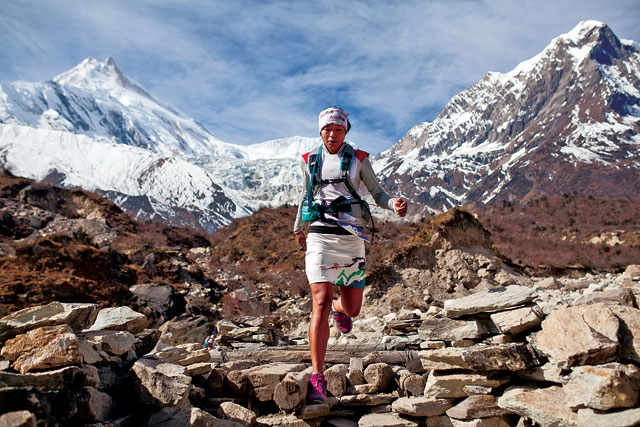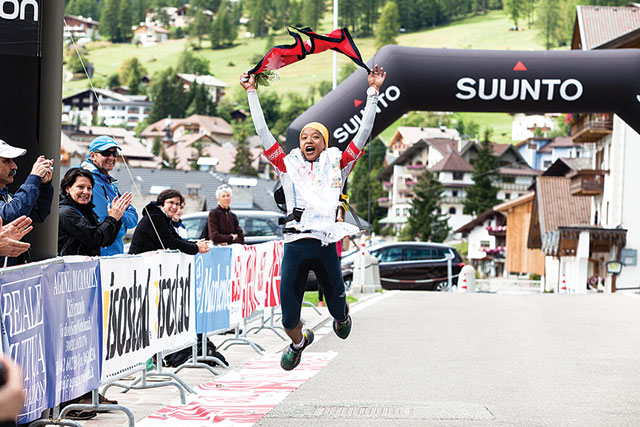
In a short period of time, Mira Rai has become a household name in Nepal. From childhood days in her village in Bhojpur, then a child soldier in the guerrilla army in her early teens, and eventually—by sheer chance—signing up for a 50-km trail running race just a few years ago, her life took several turns before her becoming the runner-up in the Skyrunning World Series in 2015. A flurry of podium positions in international races later, she got nominated and eventually was voted the National Geographic Adventurer of the Year in 2017.
How does it feel to be the National Geographic Adventurer of the Year?
I still think it’s a dream! It is definitely very valuable for my career and a strong boost in morale to train harder and perform better. But, the award goes beyond winning races. Behind the scenes are my mentor Richard Bull and coach Dhruba Bikram Malla to whom I’m immensely thankful for guiding me to the path I am on today. And, of course, the countless people who voted for me online. Regardless of my performance on the trails, National Geographic’s award would be impossible without the support and love from folks all over.
What makes you run?
I love running. There’s no better way I could explain why I run.
How did you get into running?
I used to do some sports like karate before I got into running. However, it was by chance that I registered for the Himalayan Outdoor Festival 50-km running race back in 2014, and surprisingly won gold in the women’s category. That was my first ever race. Race opportunities I got through Trail Running Nepal, and with enough mentorship, I got to run in two races in Italy, both of which I won. After this, my career took off.
What do you think contributed the most in your excellent performance, especially in your first races when you hadn’t specifically trained in long distance trail running?
It started since my childhood in a village. The demanding manual work we were required to do as girls actually prepared me physically to take on the trails. Every morning I would have to walk hours to fetch water and herd goats in the village. I did this from a very early age, as did most of the girls in my village. We were expected to do household chores, but I’d always dreamed of breaking this dogma. So, in a bid to pursue something new, I joined the Maoist army. The training included physical exercise, combat, and weapon training, as well as running, which made me stronger and more confident. Coming from a conventional society, this was something completely new to me. Receiving such skills and training would’ve been virtually impossible back in my village. Besides the physical stamina, I feel the love for adventure I picked up really helped me push myself in running races.
What are your goals in running?
For the most part, I will still be training and participating in races in Nepal and overseas. A race I’ve always wanted to do is the Ultra-Trail du Mont-Blanc in France. It’s a tough race in which professionals around the world participate. It’ll be great to see where I stand in the race. At the moment though, I’m recovering from a knee surgery that I underwent last year, but I’m improving slowly but surely.

How often do you go back home? Have you noticed the traditional mindset change in your village in any manner?
During Dashain every year, and on other special occasions, I visit home in Sano Dumma village of Bhojpur. Though I’m based mostly in Kathmandu, my family still lives in Sano Dumma, where I was born and raised. I must say that not much has changed over the years, especially considering the traditional roles women have been assigned. They are still largely preoccupied with household work.
You organized a race in your village last year. What was the main objective behind it? How did the locals receive it?
The race was generally to introduce trail running to the young crowd of Sano Dumma, and give them a platform to get noticed in running. The kids loved it! Over 120 people showed up to run on the trails that are otherwise taken for granted. It was also a way to show women that they need not only be confined in their homes with work, and also just to have the people do something different.
You are organizing trail running races in Kathmandu. Tell us more about it.
Nepal has tremendous potential in trail running, not merely the sport, but also in developing promising athletes. Rugged terrain is not an issue to tread on for many Nepalis living in villages, as they have to walk on these trails every day. It’s just a matter of giving a platform for talent to be discovered and groomed. This is why—to start with—the Trail Running Nepal team and I are organizing a series of short trail running races, called Kathmandu Trail Race Series (www.trailrunktm.com), in the valley every month. We’ve designed the routes to make them suitable for both experts and beginners.
What suggestions would you give to beginner runners?
There is always a start. Regardless of your fitness level, it is important that you watch what you eat, and exercise on a regular basis. It is less daunting than most people think! The valley is surrounded by amazing trails everywhere. Besides the health aspect of running beyond the dusty confines of the city, the views you get are incredible. Grab a friend to run with, or join one of a handful of running groups in Kathmandu. They’d be more than happy to have you. I myself was a beginner just a few years ago.
How do you plan to give back?
Well, as I mentioned, I’ll be proactively organizing running races to promote the sport and discover new talent. The race is open to people of all ages, gender, and experience level, with particular focus on women and kids. With support and collaboration on different fronts, I’m striving to make Nepal recognized as a trail running destination, getting more people involved in the sport professionally or as a hobby, and hence encourage women to do be bold, follow their dreams, and break the traditional roles defined for them by an orthodox mindset.










